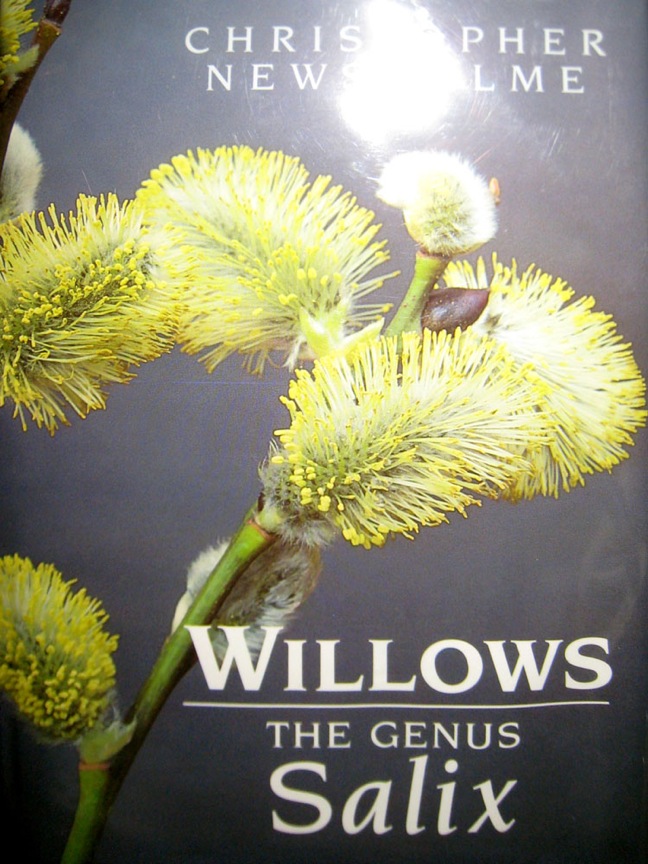
|
Willows: the genus Salix
|
a book review by Arthur Lee Jacobson
|
Willows: the genus Salix. By Christopher Newsholme. Published in 1992 by B.T. Batsford, Ltd, London, England. Hardcover, 224 pages. 65 color plates, 159 black & white line drawings. ISBN 0-7134-6881-5. (Also by Timber Press of Portland, Oregon, under ISBN 0-88192-261-7)
|
| A lovely book, clearly laid out, well illustrated, broad in scope, yet compact, it immediately beckons perusal and earns high esteem for its appearance. |
| Introductory chapters treat in overview fashion willow origins, distribution, botany, propagation, pruning, planting, and value for ornamental decoration, as well as uses in basketry, for fuel, soil-binding, etc. |
| The bulk of the volume is specific accounts in alphabetic order, arranging willows suitable for: 1) large gardens and parks, 2) small gardens, 3) rock gardens, 4) sink gardens. There is inevitably some overlap, and too little cross-referencing. |
| A British viewpoint flavors the book, as the author lives in Devon, where he has collected and studied willows since 1972. Two willow tree hybrids recently much planted in cold parts of North America are not included: 'Prairie Cascade' and Scarlet Curls®. |
| Newsholme loves willows wholeheartedly. His effective photographs show in high-quality color the impressive range of variety in habits, leaves, and catkins. No keen gardener viewing them will fail to be pleased at the diversity and beauty thus presented. The 159 painstaking line drawings are good for specific identification, on a minute level --willow catkins consist of numerous tiny florets, and these have been enlarged greatly in the drawings to reveal differences used to distinguish various taxa. |
| Different estimates number willow species between 300 and 500. This book has 231, plus a very large number of varietal taxa and hybrids. The reader who consults the book to learn about a certain kind of willow, will find a botanical description of varying depth, followed by remarks as to nativity, introduction, garden-worthiness, or the like. Too little of the latter is supplied, and one is sure Newsholme knows far more than he communicates, as when he writes of Salix sitchensis: "An interesting and very distinctive shrub" (page 166) --readers must guess what makes it so, since the author isn't specific. |
| Willows are notorious for being disputed botanically, with taxonomists being ever kept busy rearranging and renaming. Newsholme shies from scientific disputes, as do many of us, but unfortunately his nomenclature can be misleading, as in treating certain hybrid cultivars under specific names; treating taxa of the same background differently (S. x basfordiana p. 54 and S. x rubens f. basfordiana p. 116); treating separately taxa that are often considered synonymous, with no reference to the fact that other botanists unite them (S. rigida p. 114 and S. eriocephala p. 71); treating vernacular names as if they were cultivars by using single quote marks ('White Willow'). A flawless book is not required, but such blemishes could easily have been caught by expert pre-publication proof-reading. |
| The bibliography of 41 entries seems short for such an ambitious book, and lacks certain important recent treatments, such as the European Garden Flora. As the bibliographic authors are not cited in Newsholme's book, he might better have made a selected list of his suggested reading. |
In short, all the makings for an excellent and needed book are here, but it wasn't cooked long enough. Gardeners will wish there was less technical botany, and more description of ornamental merits of and fascinating stories behind the different willows; people using the book to indentify must be wary of uneven nomenclature. Its vast scope, bringing conveniently together a wealth of heretofore scattered data, plus some truly original information, make it a very valuable addition to the literature of woody plants.
|
(Originally published in the Washington Park Arboretum Bulletin in 1992 or 1993)
Back |
|
|

